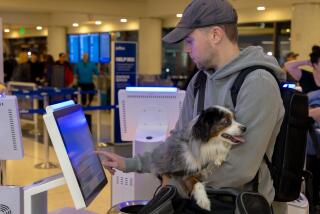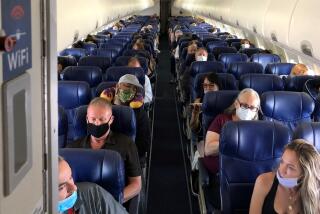Giving the Cold Shoulder to Othersâ Germs on Jets
During the holidays, airline passengers may worry about more than making their connections. They also may fret about catching a cold when theyâre stuck in a plane full of sniffling, sneezing fellow travelers.
How likely is it that youâll catch a cold while airborne? How can you defend yourself against sneezing seatmates?
An airplane cabin can be a breeding ground for cold viruses, but itâs probably no worse than a densely populated office or a home with small children, researchers say.
âAt least half or maybe more colds are spread by direct contact,â says Dr. Jack Gwaltney, a professor of medicine and head of the division of epidemiology and virology at the University of Virginia Medical School, who has published 219 studies about cold transmission. On a plane, he says, you donât have as much skin-to-skin contact as in child care, but you touch contaminated surfaces.
Letâs say your seatmate sneezes and some of the airborne virus lands on your tray table. You touch it when you unlatch your tray table, then you invite it in when you touch your eyes or nose.
Or the flight attendant has a cold, and his virus migrates to your dinner tray. Or a sneezer uses the lavatory ahead of you and leaves her virus on the door handle.
The density of people in an enclosed space also affects the likelihood of catching a bug, says Dr. Jonathan Fielding, director of public health for the Los Angeles County Department of Health Services. So boarding a packed-to-the-gills flight is, statistically, riskier for catching a cold than boarding a half-empty one.
Gwaltney agrees that the more packed the plane, the greater the risk that cold viruses will spread. But, he adds, heâs not sure whether the risk aloft is greater than being at home with young children who have colds.
What about the much-maligned air quality in planes? What are the chances that cold viruses will be spewed out of the air system?
Itâs much more likely that youâd get the virus by touching a contaminated surface, the experts say.
The typical cold virus measures 30 nanometers across, Gwaltney says. But cold viruses donât travel alone. Theyâre stuck in mucus. The âcritical particleâ--thatâs the virus plus the mucus--measures about 2 microns. A particle this small can float in the air, Gwaltney says, âbut the HEPA filters can get that.â (If the particle measures 10 microns, it falls to the floor, Gwaltney says.)
Airplanes equipped with the newer HEPA filters are 99.97% effective at trapping particles down to a size of 0.3 micron, says Duane Willse, who is on the standards committee of the American Society of Heating, Refrigerating and Air-Conditioning Engineers.
To minimize the risk of catching a cold aloft, try to avoid contact with the virus. âDonât put your fingers in your eyes or your nose,â Gwaltney says. And wash your hands frequently--not obsessively, but it does make sense, he says, to wash up after deplaning.
You canât choose your seatmates, but you can try to avoid the germiest ones. Be aware of who is around you, says Dr. Stephen Ross, a family practice physician and chief of staff at Santa Monica-UCLA Medical Center. If people next to you are sick, he says, ask for a new seat if there are vacant ones. He also suggests carrying antiseptic hand wipes to use when you canât get to a sink for hand washing, and to wipe down the tray table and armrest.
The use of saline nasal spray when flying is often recommended because itâs thought that dry nasal passages are more hospitable to the cold virus. Gwaltney says his research refutes that theory.
âIf a cold virus is dropped into the nose, 90% or more of people get infected if they have no immunity to that virus,â Gwaltney says. âThe nose can be as dry as the Sahara or as wet as the Atlantic. Humidity only affects the virus when it is outside of people.â
And Gwaltney says wearing a surgical mask to ward off germs is impractical; for one thing, your eyes would still be exposed. âI personally would not wear one,â he says. âItâs uncomfortable.â
Healthy Traveler appears twice monthly. Kathleen Doheny can be reached at [email protected].
More to Read
Sign up for The Wild
Weâll help you find the best places to hike, bike and run, as well as the perfect silent spots for meditation and yoga.
You may occasionally receive promotional content from the Los Angeles Times.






